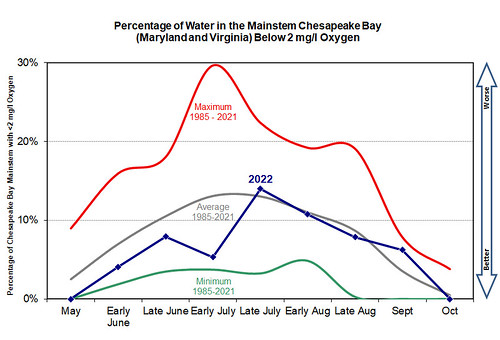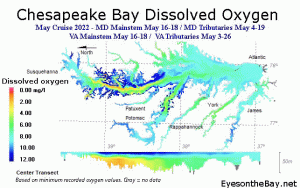
Last Chesapeake Bay Hypoxia Record for 2022
Bay Dissolved Oxygen Issues Better Than Ordinary
 Water tracking information gathered by the Maryland Division of Natural Resources (DNR) and also Old Ascendancy College reveal that liquified oxygen problems in the Chesapeake Bay mainstem of Maryland and also Virginia were far better than typical for May-October 2022.
Water tracking information gathered by the Maryland Division of Natural Resources (DNR) and also Old Ascendancy College reveal that liquified oxygen problems in the Chesapeake Bay mainstem of Maryland and also Virginia were far better than typical for May-October 2022.
The hypoxic water quantity– waters with much less than 2 milligrams per litre (mg/l) oxygen– balanced 0.65 cubic miles throughout May-October 2022, contrasted to the historic standard (1985-2021) of 0.79 cubic miles. 2022 placed 10th finest of 38 years of tracking. Furthermore, a seasonal standard of 0.15 cubic miles of anoxia (waters with much less than 0.2 mg/l oxygen) was observed versus a historic standard of 0.14.

Click to stimulate visuals
Liquified oxygen was far better than standard in Might with very early July, adhered to by close to typical problems in late July with August. Hypoxia stuck around right into September with even worse than typical problems of 0.77 cubic miles observed versus a September historic standard of 0.44. No hypoxia was observed in October, yet climate condition and also research study vessel schedule restricted Maryland from keeping an eye on a variety of reduced Maryland bay terminals and also pressed Virginia’s tracking towards completion of the month when no hypoxia would certainly be anticipated.
 Seasonal hypoxia in the Chesapeake Bay mainstem can normally be anticipated based upon freshwater circulation right into the Bay from January with May. Freshwater circulation is a sign of just how much nutrient (nitrogen and also phosphorus) drainage might be getting in the Bay. Nevertheless, problems such as wind, temperature level, and also rainfall, can give some impact over the irregularity of observed hypoxic quantities. Chesapeake Bay freshwater inflows, as approximated by the united state Geological Study (USGS), were less than typical and also near the historic most affordable 25th percentile June with August. Paired with currently decreased typical circulations for January with Might, these problems might have aided assistance close to far better than typical problems for a lot of the summertime.
Seasonal hypoxia in the Chesapeake Bay mainstem can normally be anticipated based upon freshwater circulation right into the Bay from January with May. Freshwater circulation is a sign of just how much nutrient (nitrogen and also phosphorus) drainage might be getting in the Bay. Nevertheless, problems such as wind, temperature level, and also rainfall, can give some impact over the irregularity of observed hypoxic quantities. Chesapeake Bay freshwater inflows, as approximated by the united state Geological Study (USGS), were less than typical and also near the historic most affordable 25th percentile June with August. Paired with currently decreased typical circulations for January with Might, these problems might have aided assistance close to far better than typical problems for a lot of the summertime.
The National Oceanic and also Atmospheric Management’s National Centers for Environmental Info reported that Maryland month-to-month typical air temperature levels were above standard from Might with September 2022, and also winds were close to standard Warmer air brings about warmer Bay waters, which consequently hold much less oxygen and also assistance greater prices of oxygen intake by microbes. These greater temperature levels and also absence of significant wind occasions that assist blending of oxygen right into much deeper waters, might have alleviated also much better liquified oxygen problems.
In September, moves enhanced to near the highest possible 75th historic percentile. While these circulations might not have actually instantly sustained extra hypoxia, the lighter inbound freshwater in addition to denser deep sea might have boosted and also kept water column stratification, avoiding oxygen from blending right into much deeper waters, causing the above typical hypoxia quantity sticking around right into September. Winds from the residues of Storm Ian in very early October most likely dissipated any type of continuing to be hypoxia in the Bay.
Maryland and also Virginia incorporated outcomes exist for the mainstem Bay to be extra similar to the e annual seasonal projection by the United State Epa’s Chesapeake Bay Program, USGS, College of Maryland Facility for Environmental Scientific Research, and also College of Michigan.
The 2022 projection, launched in late June, forecasted Chesapeake Bay mainstem hypoxic quantity to be 13% less than the 37-year standard as a result of decreased riverine nutrient filling from January with May 2022. The lowered quantity of nutrients getting in the Bay can be credited to less than typical springtime rainfall, along with nutrient monitoring initiatives. Maryland and also Virginia’s 2022 tracking results very closely matched the projection of better-than-average problems. The tracking and also seasonal projection outcomes likewise very closely matched the better-than-average problems forecasted from computer system modeling carried out at the Virginia Institute of Marine Scientific Research.
Crabs, fish, oysters, and also various other animals in the Chesapeake Bay call for oxygen to make it through. Researchers and also natural deposit supervisors research the quantity and also period of Bay hypoxia to identify feasible effects to bay life, and also track enhancements as a result of vitamins and mineral monitoring initiatives.
Every year, DNR calculates hypoxia quantities from the water high quality information gathered by DNR and also Virginia Division of Environmental High Quality. Water high quality information collection happens all year, and also is moneyed by these states and also the Chesapeake Bay Program. Bay hypoxia coverage will certainly return to in May 2023. Added Maryland water high quality information and also info, consisting of DNR’s hypoxic quantity computation approaches, can be discovered at DNR’s Eyes on the Bay site.
